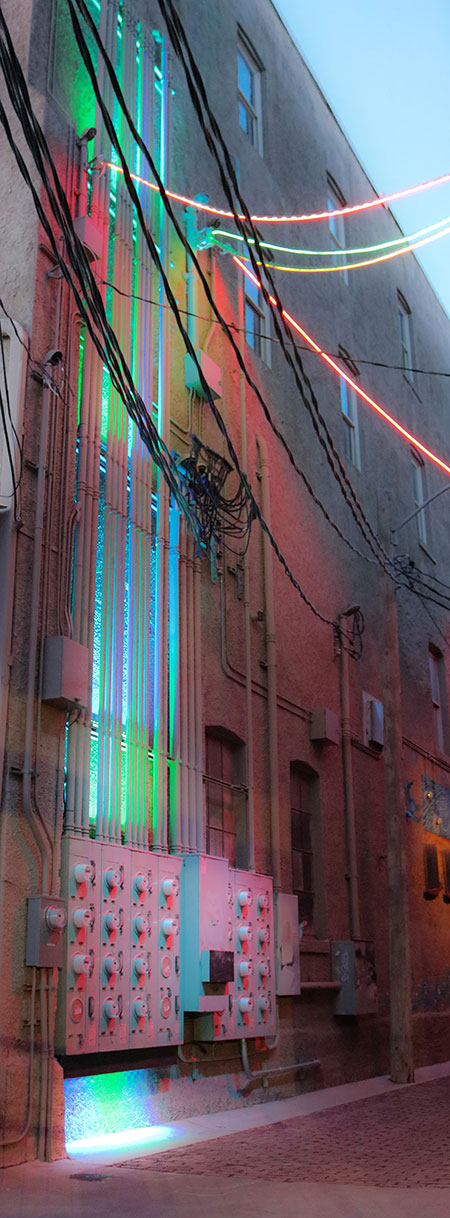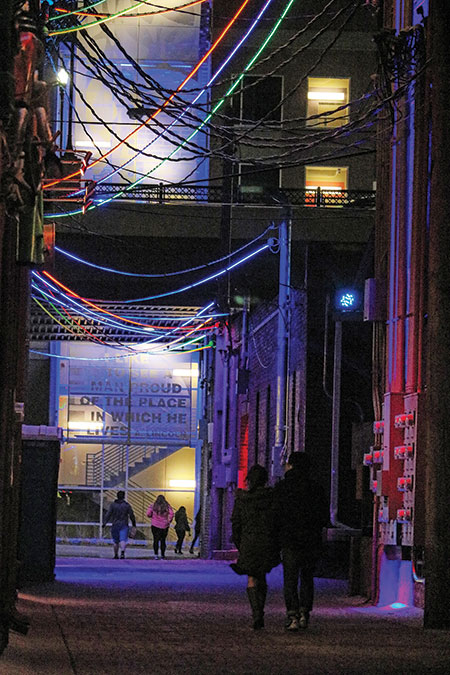A lighting revamp morphs a century-old pathway into a work of art
By Katie Nale
The lighting of Gallery Alley in Lincoln, NE, is a work of art as unexpected as the alley itself. After the city built a parking garage at its south end, the tucked-away service alley started seeing heavy foot traffic. Quickly realizing the need for an updated lighting solution along the pathway, the city recruited lighting design firm Patrick B. Quigley & Associates (PBQA), Torrance, CA, having previously used the firm to develop a conceptual plan in another district of Lincoln. “The city knew that we not only did city planning, but that like most lighting designers, we do nearly everything, including lighting art,” says design principal Patrick Quigley.
Surrounded by a colony of artists, the 240 ft by 18 ft alley has been used for years as a “guerilla art zone” where artists go to splash temporary art pieces on the walls, as well as more significant (and more permanent) murals, abstract masks and sculptures. Much of the reason for this has to do with a local artist named Anne Burkholder. Her building, The Burkholder Project, flanks a portion of the alley and is filled with lofts and studios belonging to local artists. The consequence of a building full of artists is—unsurprisingly—art.
Knowing the city had decided to invest in a safer alley, Burkholder proposed also doing something to elevate the art in the alley. Heeding her advice, the city came to PBQA with the goal of a safely lit alley that would also showcase the local talent. The lighting designers came up with some unexpected additions to the program.
WIRED UP
The first thing Quigley’s team noticed was that there were more opportunities in the alley than the city originally thought. “We found ourselves thinking, ‘Don’t clean this up, make it more of what it is,’ ”says Quigley. What it is was an industrial blue-collar piece of the city fabric. There was a cacophony of abandoned and active electrical wire located in the alley that, according to Quigley, looked like art when you squinted at it just right.
With that observation, the project’s list of goals expanded to include highlighting the alley’s working class history. “This is when we convinced the city that light-art could be a part of the planning solution, that we could take all of the historic infrastructure components and glorify these as light-art features,” says Quigley. In doing so, the lighting design firm became one of the artists represented in the alley with the byproduct of its artwork being higher illumination levels and a perceived sense of safety.
Possibly the most important piece in Quigley’s blue-collar design is the “Wire Symphony”—the luminous tubes of LED light that drape throughout the alley in a way that mimics the already existing electrical wire. “This mounting technique had, to our knowledge, never been done before,” says Quigley. Linear LED products are not typically suspended, but rather attached to a structural surface. When Quigley finally found a manufacturer—GreenLED—that would agree to the project, PBQA had to submit to GreenLED’s requirement to use mounting clips every 3 in. along the suspension cable (Figure 1). A welcome surprise was that by
night the clips have no effect on the aesthetic, but by day, they add to the industrial feel of the alley.
Cobra heads and wall-pack fixtures served as the alley’s main source of lighting before the upgrade. While the cobra heads are used only after the nightlife of the nearby Haymarket District has shut down, the wall packs have been co-opted into the light-art elements. Each has been fitted with a dichroic lens from Rosco that bathes the alley in a lavender glow and provides artful contrast to a 100-year-old wooden loading dock door typically lit in saturated red.
While the “Wire Symphony” is not capable of changing colors, other key industrial elements of the alley are lit with RGB LEDs and can create lighting scenes for special events. Pole-mounted transformer cans are lit from the rooftop using RGB LED spotlights from Insight. Color-changing wall grazers from Traxon light the historic dock door, as well as the “Torched Meters” piece in the alley’s north end. The still operational meters sprout a prodigious array of vertical risers that are seen in silhouette, thanks to the grazers mounted to the wall behind them.
ILLUMINATED ESCORT
After the development of the parking garage, the alley became an unexpected shortcut to the city’s Haymarket District—an entertainment and nightlife hub for local students. PBQA acknowledged the need for the alley to succeed not just as an activated, interesting space, but also on a city planning level. The alley should move people into the Haymarket District. Using the concept of phototropism, the idea that our eyes are attracted to the brightest point in space, Quigley ensured that the alley’s terminal vistas—the garage façade on the south end and Lazelo’s Brewery & Grill’s façade on the north end—were the most brightly lit elements of the project.

Tying these two destination points together is the “Wire Symphony,” which escorts visitors down the length of the alley. The pace of strolling visitors is modulated by how brightly the various interceding art elements are lit. If the art is lit more brightly, pedestrians slow to gaze at the art. On the other hand, if the art pieces are dimmed, movement toward the terminal vistas at the end of the alley tends to quicken. The project is choreographed to encourage people to enjoy the art, while also ensuring that they continue to migrate down the alley.
DESTINATION
Contracted in 2013, PBQA completed work on Gallery Alley in 2016 with a nine-month break between the north and south end of the alley—each a block long. The lighting design cost came to $143,000, a controversial figure at the time of sitting Mayor Chris Beutler’s third-term re-election campaign in 2015. However, since the alley’s completion, it can be argued that the city’s supportive mayor and its citizens have gotten more than the safely lit space they initially bargained for. “The alley is no longer just a shortcut to the Haymarket District—it has become a destination. People come here when they show their relatives around town. It helps market Lincoln,” says Quigley.
Jennifer Klein of local architecture and engineering firm, The Clark Enersen Partners, provided the electrical engineering for the project. PBQA won an IES Los Angeles Section Lumen West Award of Excellence for exterior lighting design in 2017 for Gallery Alley. It also won a 2017 IES Illumination Award of Merit.
It the midst of the alley’s success, the initial issue of safety in the alley has been addressed twice over, as the space is not only well lit now, but also busy. “Bad things don’t happen if a space is occupied,” says Quigley. “And the alley
is occupied all of the time now. That’s kind of an extraordinary outcome.”


